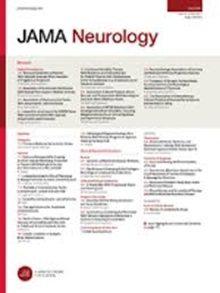Posttreatment Amyloid Levels and Clinical Outcomes Following Donanemab for Early Symptomatic Alzheimer Disease: A Secondary Analysis of the TRAILBLAZER-ALZ 2 Randomized Clinical Trial.
IF 21.3
1区 医学
Q1 CLINICAL NEUROLOGY
引用次数: 0
Abstract
Importance Accumulation of amyloid plaque drives pathogenesis of Alzheimer disease (AD). Reduction of amyloid via amyloid-targeting therapies may result in clinical benefit. Objective To assess the correlation of posttreatment amyloid levels with clinical outcomes and biomarkers in AD. Design, Setting, and Participants This was a post hoc exploratory analysis from the randomized, placebo-controlled phase 3 trial, TRAILBLAZER-ALZ 2, conducted June 2020 through April 2023 at 277 medical research centers/hospitals in 8 countries. A total of 8240 participants aged 60 to 85 years with early symptomatic AD with amyloid and tau pathology based on positron emission tomography (PET) imaging were assessed for eligibility. Of these, 6504 participants were excluded predominantly due to inadequate amyloid or tau pathology. The current analysis included 1582 participants (766 in the donanemab group and 816 in the placebo group) with baseline and at least 1 posttreatment assessment. Data analysis took place from July 2024 to March 2025. Interventions Participants were randomized 1:1 to receive donanemab (700 mg for the first 3 doses and 1400 mg thereafter) or placebo intravenously every 4 weeks for up to 72 weeks, with outcomes assessed through 76 weeks. Main Outcomes and Measures Participants were categorized into 1 of 10 groups (deciles) based on their lowest amyloid value observed posttreatment. Clinical progression was assessed via changes in integrated Alzheimer's Disease Rating Scale (iADRS) and Clinical Dementia Rating-Sum of Boxes (CDR-SB) scores. Plasma biomarkers measured included phosphorylated tau 217 (p-tau217), p-tau181, glial fibrillary acidic protein (GFAP), and neurofilament light chain (NfL). Correlations between the median amyloid level in each decile were assessed with 76-week least-squares mean changes in each outcome and biomarker. Results Analyses included 1582 participants, including 766 treated with donanemab and 816 with placebo. The mean (SD) age was 72.9 (6.2) years, and 900 participants (56.9%) were female. Participants who received donanemab had lower posttreatment amyloid values than those in the placebo group. Across the trial population, lower posttreatment amyloid levels were correlated with slower clinical progression as measured by iADRS score (R2, 0.73 [95% CI, 0.37-0.97]) and CDR-SB score (R2, 0.87 [95% CI, 0.70-0.97]) and with decreases in p-tau217 (R2, 0.86 [95% CI, 0.73-0.97]), p-tau181 (R2, 0.88 [95% CI, 0.77-0.97]), and GFAP (R2, 0.87 [95% CI, 0.76-0.97]). There was no correlation between posttreatment amyloid value and NfL (R2, 0.03 [95% CI, 0.00-0.54]). Conclusions and Relevance The findings in this secondary analysis of a randomized clinical trial demonstrating a correlation between posttreatment amyloid plaque level and clinical benefit support amyloid plaque removal as the mechanism of action for donanemab treatment and the level of amyloid plaque as a potential surrogate biomarker in amyloid-targeting therapies. Trial Registration ClinicalTrials.gov Identifier: NCT04437511.多南单抗治疗早期症状性阿尔茨海默病后淀粉样蛋白水平和临床结果:对trailblazer - alz2随机临床试验的二次分析
淀粉样斑块的积累驱动阿尔茨海默病(AD)的发病机制。通过淀粉样蛋白靶向治疗减少淀粉样蛋白可能会带来临床益处。目的探讨阿尔茨海默病治疗后淀粉样蛋白水平与临床结局和生物标志物的相关性。设计、环境和参与者这是一项针对随机、安慰剂对照的3期试验TRAILBLAZER-ALZ 2的事后探索性分析,该试验于2020年6月至2023年4月在8个国家的277个医学研究中心/医院进行。共有8240名年龄在60至85岁之间的早期症状性AD患者,基于正电子发射断层扫描(PET)成像评估淀粉样蛋白和tau病理。其中,6504名参与者主要因淀粉样蛋白或tau蛋白病理学不足而被排除在外。目前的分析包括1582名参与者(donanemab组766名,安慰剂组816名),基线和至少1次治疗后评估。数据分析时间为2024年7月至2025年3月。干预措施:参与者以1:1的比例随机分配,每4周静脉注射多纳单抗(前3次剂量为700毫克,之后为1400毫克)或安慰剂,持续72周,直到76周评估结果。根据治疗后观察到的最低淀粉样蛋白值,将参与者分为10组(十分位数)中的1组。通过综合阿尔茨海默病评定量表(iADRS)和临床痴呆评定盒和(CDR-SB)评分的变化来评估临床进展。血浆生物标志物包括磷酸化tau217 (p-tau217)、p-tau181、胶质纤维酸性蛋白(GFAP)和神经丝轻链(NfL)。每个十分位数中位淀粉样蛋白水平之间的相关性通过76周内每个结果和生物标志物的最小二乘平均变化来评估。分析包括1582名参与者,其中766名接受多纳单抗治疗,816名接受安慰剂治疗。平均(SD)年龄为72.9(6.2)岁,900名参与者(56.9%)为女性。接受donanemab治疗的参与者治疗后淀粉样蛋白值低于安慰剂组。通过iADRS评分(R2, 0.73 [95% CI, 0.37-0.97])和CDR-SB评分(R2, 0.87 [95% CI, 0.70-0.97])以及p-tau217 (R2, 0.86 [95% CI, 0.73-0.97])、p-tau181 (R2, 0.88 [95% CI, 0.77-0.97])和GFAP (R2, 0.87 [95% CI, 0.76-0.97])的降低,在整个试验人群中,较低的治疗后淀粉样蛋白水平与较慢的临床进展相关。治疗后淀粉样蛋白值与NfL无相关性(R2, 0.03 [95% CI, 0.00-0.54])。结论和相关性这项随机临床试验的二次分析结果表明,治疗后淀粉样斑块水平与临床获益之间存在相关性,支持淀粉样斑块去除是donanemab治疗的作用机制,以及淀粉样斑块水平作为淀粉样靶向治疗的潜在替代生物标志物。临床试验注册号:NCT04437511。
本文章由计算机程序翻译,如有差异,请以英文原文为准。
求助全文
约1分钟内获得全文
求助全文
来源期刊

JAMA neurology
CLINICAL NEUROLOGY-
CiteScore
41.90
自引率
1.70%
发文量
250
期刊介绍:
JAMA Neurology is an international peer-reviewed journal for physicians caring for people with neurologic disorders and those interested in the structure and function of the normal and diseased nervous system. The Archives of Neurology & Psychiatry began publication in 1919 and, in 1959, became 2 separate journals: Archives of Neurology and Archives of General Psychiatry. In 2013, their names changed to JAMA Neurology and JAMA Psychiatry, respectively. JAMA Neurology is a member of the JAMA Network, a consortium of peer-reviewed, general medical and specialty publications.
 求助内容:
求助内容: 应助结果提醒方式:
应助结果提醒方式:


